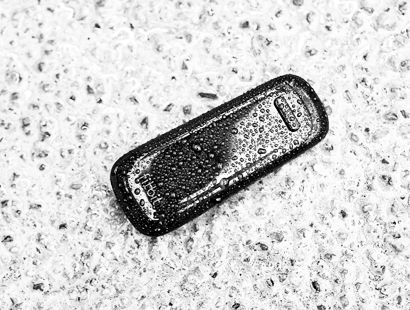As an embedded software engineer who is interested in bringing HCI design practice to embedded devices, I often hear people say, “Oh but we don’t have a display on our device, so I’m not sure we need that”. Somehow, the embedded systems community seems to have decided that well designed interactions only apply to software with a GUI. I’d like to argue that’s not true. In fact, embedded devices not only need good interaction design, but they need it more than traditional (computer-based) software.
1. Embedded devices can’t fall back on default interactions
 Traditional software solutions can always fall back to the screen/keyboard/mouse interaction. For example, when developing image editing software, you can always start with a mouse and keyboard interface, despite the fact that a tablet interface may be better.
Traditional software solutions can always fall back to the screen/keyboard/mouse interaction. For example, when developing image editing software, you can always start with a mouse and keyboard interface, despite the fact that a tablet interface may be better.
But embedded devices are almost defined by their lack of mouse and keyboard. The embedded designer has no default interaction, they need to make the difficult choices up front about what form of input they can support and how they can relay feedback or information.
The embedded designer has no default interaction, they need to make the difficult choices up front.
A very simple example of this is designing a device that uses WiFi for connectivity. Entering a WEP key is challenging under any circumstances, imagine how much more so without a real keyboard. Is it even possible without a display?
2. Embedded devices go everywhere
 This means they are exposed to the elements, challenging lighting conditions and portability constraints in ways that regular software is not. For e.g. wearable fitness devices often get ruined by sweat which can be quite corrosive to metals. The latest offerings, such as the Fitbit One, are now sweatproof and rainproof, but you can imagine in the early devices, the software developers had to contend with false readings due to moisture on the sensor.
This means they are exposed to the elements, challenging lighting conditions and portability constraints in ways that regular software is not. For e.g. wearable fitness devices often get ruined by sweat which can be quite corrosive to metals. The latest offerings, such as the Fitbit One, are now sweatproof and rainproof, but you can imagine in the early devices, the software developers had to contend with false readings due to moisture on the sensor.
3. Embedded devices are not the center of attention
Of course, they can be. Certainly, the latest phones and tablets garner a lot of attention. But a vast majority of embedded devices have to operate in a context where the user has other tasks and goals taking their attention. Attention is an increasingly precious and scarce resource as more and more of our devices compete for it. A well-designed device should work well in the background, and capture your attention judiciously, if at all.
A well-designed device should work well in the background, and capture your attention judiciously, if at all.
Think about car entertainment systems, they’re best when easily operated, preferably without even having to glance at them, because the user’s main goal is driving, not playing music. In fact, to avoid users taking their hands off the wheel, most newer vehicles provide controls embedded in the steering wheel itself.
4. Embedded devices want you to twist them, pull them, bop them
 Remember that old game, Bop It
Remember that old game, Bop It? Twisting, pulling, yes even bopping are affordances. If you haven’t heard the term, Wikipedia says, “An affordance is a quality of an object, or an environment, which allows an individual to perform an action. For example, a knob affords twisting, and perhaps pushing, while a cord affords pulling.”
Keyboards and mice have some affordances but they’ve been well explored. Embedded devices have all sorts of great new affordances, because they’re not tied to a particular form. They can take advantage of the many ways that we interact with the natural world around us.
Embedded devices enable a whole new universe of interactions that are unexplored solely because the keyboard and mouse didn’t afford them.
A company called Blast Motion creates pucks that can be embedded into golf clubs and tennis rackets to analyze your swing. The interface is simply swinging your golf club. Pinch-to-zoom and multi-touch didn’t really become popular until you had to use your hand to interact with your iPhone. Embedded devices enable a whole new universe of interactions that are unexplored solely because the keyboard and mouse didn’t afford them.
5. Customers care.
Finally, embedded designers should care because their customers do. Back in the mid 2000s, everyone thought the cellphone market in the US was saturated, and the only way to sell phones was to make ultra low cost versions for China and India. Then, Apple came out with the first iPhone in 2007, and all of a sudden, everyone was willing to pay $499 for a cellphone.
Actions that were frustrating before seemed effortless, intuitive… fun, even.
Why? There was nothing special about the hardware and software, technologically speaking. What was special was the interaction experience it gave users. Actions that were frustrating before seemed effortless, intuitive… fun, even. Do you know how many grandparents are happy to use an iPhone? Grandparents! The very same ones that you spend hours setting up Blu-ray players and digital frames for every Christmas.
So, what now?
Well, that’s the longest rant yet. But I absolutely believe that embedded devices are the next frontier for computing. Low power networking, sensing technologies and fast processors are converging right now making a lot of amazing products possible. But these products won’t go far unless we take the next step.
The only way to move the product from the hands of a few early adopters to the masses is to learn about interaction design, to think about users, their context and goals, and iterate the design until the product is an absolute delight to use.
To start, Don Norman’s excellent book The Design of Everyday Things will get you to look at everything around you as a designed interface.
The Interaction Design Encyclopedia is a great resource explaining the terms and concepts.
Scott Klemmer, Stanford professor and HCI star, has a free HCI course on Coursera.
Are you going to start thinking about how to design interactions with your product? Post your thoughts below!

